POULTRY DISEASES AND CONTROL
POULTRY DISEASES AND CONTROL
Newcastle (ND)
- Newcastle disease is caused by virus
- Affects chickens of all ages
- There is no curing drug for Newcastle
- What is required and important is Prevention.
Clinical signs
- Fever
- Off feed
- Respiratory signs: Difficult breathing, sneezing, coughing
- Torticollis (neck twisting)
- Greenish diarrhoea
- Drooping wings
- High mortality which can get to 100%

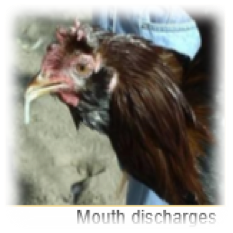
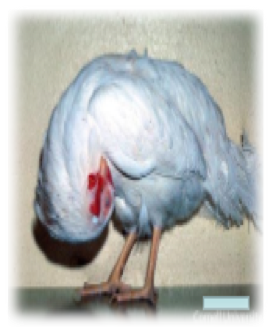
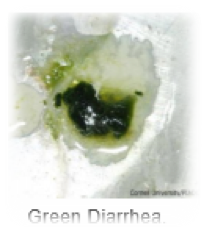

Prevention
- Remove sick chickens from the rest of the flock
- Provide Prevention measures like vaccination before chicks start showing signs of illness
- Do not allow visitors to enter the khola.
- Provide disinfectant on the door step for foot bath
- Vaccinate chickens against ND every 3 – 4 months intervals with Lasota or I2 vaccine

Gumboro Disease
- Gumboro disease is caused by virus
- It affects chickens of day old up 8 weeks old
- Is spread by aerosols, dust, droppings, utensils and by movement of live birds or carcasses
- Gumboro can cause mortality of about 50%.
Clinical signs
- Depression
- Off food
- Excessive water drinking
- The sick chicken sits back on its cloaca and have yellowish diarrhea
- Drooping wings
- Death occurs within few days.
Prevention
- Practice of good khola and feed hygiene is vital to prevent and control the disease
- Clean and disinfect the khola with a 4% solution of formalin in water between batches of birds
- Leave the khola empty for at least a week after cleaning
- Rear young chicks separate from older ones
- Avoid visiting other farmers’ kholas and prevent other farmers visiting your kholas
- Vaccinate your parent stock to pass immunity to their chicks in yolk
- Vaccinate chicks with bursin–2 vaccine at 1 week old and repeat at 3 weeks old
- Ensure that always remove all chickens showing Clinical signs of Gumboro from the flock
Coccidiosis
- Coccidiosis is caused by a protozoa called coccidia
- It affects chickens of all types and all ages
- The parasites multiply in the intestines and destroys the intestine lining
Mode of spread
- Coccidiosis is spread from bird to bird through eating contaminated feed, water and litter by the coccidian oosts (eggs)
- Coccidian can be carried by people, equipment or animals from place to place but the main source of infection are the chickens
- Coccidian can survive in the litter or soil for over one year
Clinical signs
- Bloody diarrhea
- Depression
- Drooping wings
- Weight loss and paleness
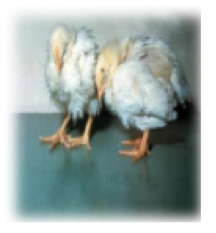
Prevention
- Keep litter dry. Remove any wet litter around the drinkers always
- Add coccidiostant in the feed. Some commercial feeds in Malawi contain a drug to prevent coccidiosis
- Don’t mix birds of different ages as the older birds will affect the younger ones
- Don’t over crowd chickens in the khola
- Clean and disinfect house at the end of a batch of birds. This will reduce the challenge to the new batch
- Maintain khola hygiene.
Treatment
- Common drugs include: Sulphur based antibiotics such as Triple Sulphur or “Anticoc”, Amprolium and ESB3.
- Always read and understand properly and follow the instructions on the label/package of the drugs
Fowl pox
- Fowl pox is a viral disease
- It affects all types of poultry and all ages
- The virus is very resistant and can withstand drying for long periods (up to 10 years)
- The disease usually spreads relatively slowly through a flock and may persist for 2 to 3 months
- The virus enters through small cuts in the mouth or through injuries to the comb, wattles or skin as a result of pecking or other injuries
Clinical signs
- Start as small white lumps which grow rapidly and turn brown commonly seen on the comb, face and wattles
- After 2-3 weeks these dry up and become scabby
- In severe cases Clinical signs can occur on the legs, feet and body. If these scabs are removed they leave a raw bleeding area
- Fowl pox rarely causes high mortality but will cause reduced egg production in laying birds
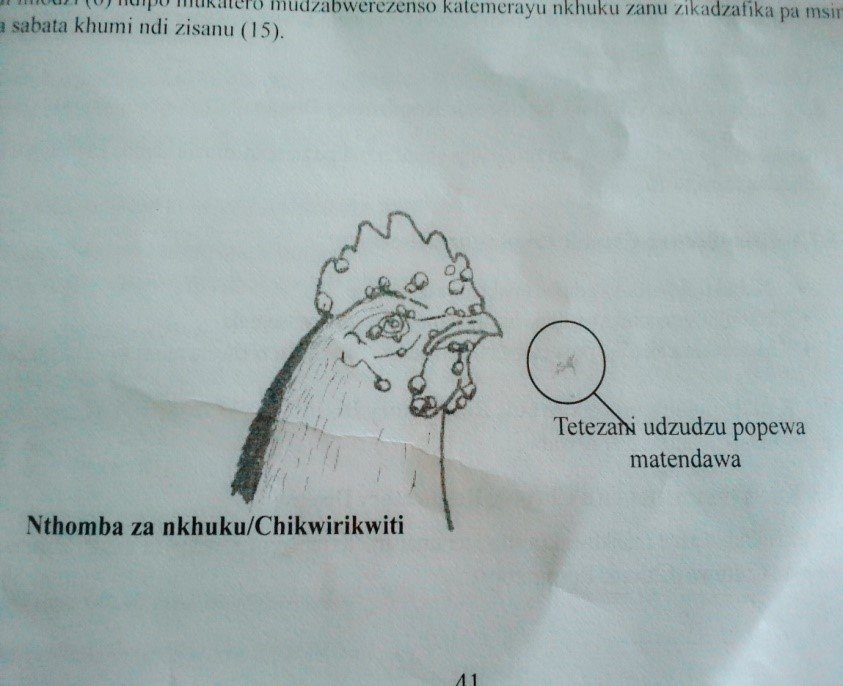
Prevention
- Vaccinate chickens against the disease with Poxine vaccine once only between 7 and 16 weeks of life
Treatment
- There is no treatment for Fowl pox.
Infectious Coryza
- It is caused by bacteria
- It is usually acute and sometimes chronic, highly infectious disease
- It is characterized by catarrhal inflammation of the upper respiratory tract especially nasal and sinus mucosae
- Route if infection is conjunctival or nasal
- The bacteria survives 2-3 days outside the bird but is easily killed by heat
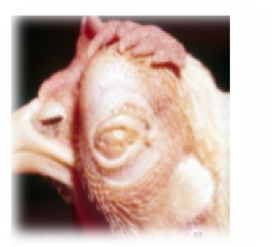
Clinical signs
- Facial swelling, purulent ocular and nasal discharge
- Swollen wattles
- Sneezing and Dysponea (difficult breathing)
- Loss of condition and loss of appetite
- Reduction in egg production
Treatment
- Treatment drugs like Streptomycin, Dihydrostreptomycin can be given but follow instructions
- Ticks, mites
- These are ecto-parasites that suck blood from the chickens
Clinical signs
- Actually the parasites are seen on the chickens
- Chickens are restless
- They keep on scratching themselves
- They bath in sand or dust or litter
- Affected chicken are pale (comb and wattles are pale)
Prevention
- Sweep in the khola regularly and maintain good hygiene.
- Use acaricides like Actelic dust to treat the affected chickens and infested kholas
Worm infestation
- Chickens also get worm infestation
- Worms affect chickens through eating contaminated feed or water with worm eggs through droppings
- Affected chickens are pale, stunted
- They have drooping wings
- They lose weight
- There is reduced egg production
- There is diarrhea
Prevention
- Maintain khola hygiene
- Periodically deworm chickens preferably just on on-set of rain season and off-set of rain season and also to treat if they infested. Dewormers include drugs like Piperazine.
Follow the vaccination programs as illustrated in the following tables.
Disease vaccination programme in layers
Disease vaccination programme in broilers


